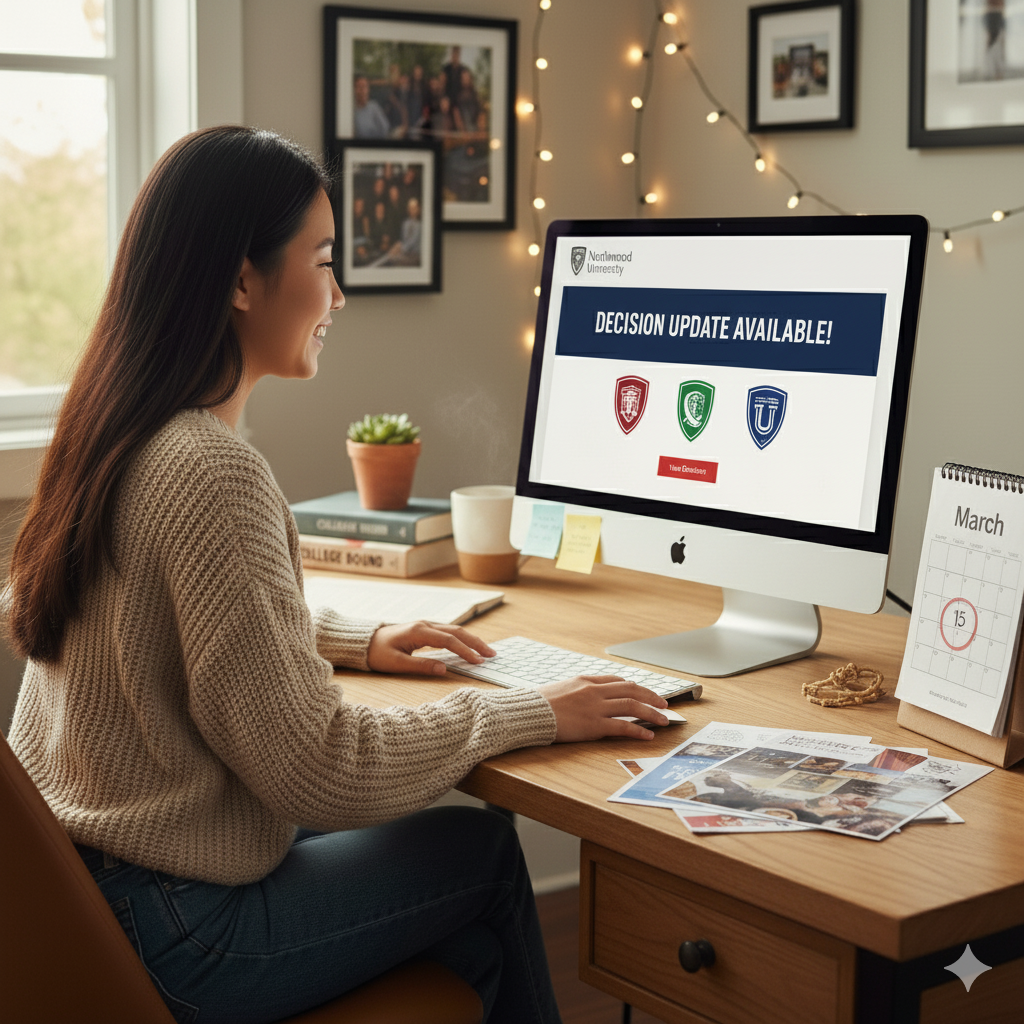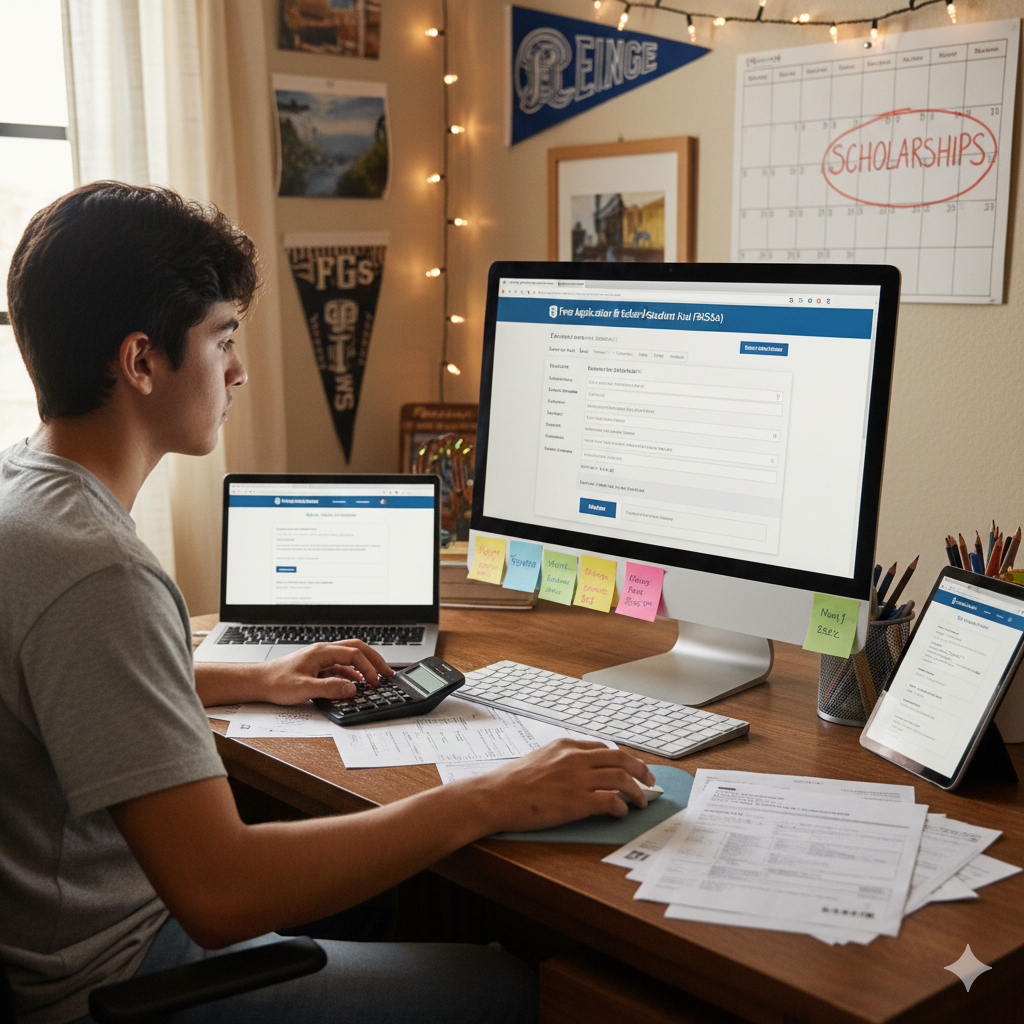You’ve done the hard part, spending countless hours on essays, gathering materials, and finally hitting that submit button. But your college application journey isn’t quite over. The period between submission and decision is crucial for organizing your next steps, managing communications, and ensuring your applications are complete. So don’t fall into the trap of just waiting! Because incomplete applications can unfortunately come back to you as denials of admission. So you’ll want to stay on top of your applications – and we’ve got just the thing to help you out: our comprehensive post-application checklist detailing what you need to do after submitting your college applications!
☐ Set-Up Portals & Email Accounts

Win more scholarships with less effort
Simplify and focus your application process with the one-stop platform for vetted scholarships.
Check for scholarshipsThe first responses you’ll receive from each college are confirmation emails and instructions on setting up your applicant portal and a dedicated college email account. You’ll receive so many of these initial communications that it can be tempting to ignore them, promising yourself you’ll get to them eventually. But that would be a poor decision, as the colleges will ONLY contact you via your portals and new college email accounts, so if you delay setting everything up, you’ll miss-out on important communications. With that in mind:
- Immediately set up your applicant portal and the college email account for every institution that provides them.
- To avoid missing critical updates, it’s highly recommended to forward all of your newly-setup college email accounts to your personal email address. This makes it easier to track everything in one place.
☐ Monitor Your Applicant Portals

Your applicant portals are your single source of truth for the status of your application at each college you’ve applied to.
Early Applicants
For colleges you applied to Early Decision (ED) or Early Action (EA), check your portals daily. These decisions often come out sooner.
Regular Applicants
For Regular Decision (RD), check at least a few times a week initially. As the decision release dates approach (typically in late March/early April), switch to checking daily.
Worried You Won’t Check Your Portals Often?
Many students find it overwhelming to constantly have to check their portals. This is particularly true if you’ve applied to numerous colleges. In all likelihood, you know yourself well. If you already suspect you won’t do a great job of monitoring your portals, share your portal login credentials with your parent / guardian and ask them to partner with you in monitoring your portal accounts. By doubling up on the monitoring, it will be much easier to track your application statuses.
☐ Submit All Supplementary Materials

Even after submitting your primary application, colleges may still require additional documents to consider your file complete.
Required Documents:
Log into your portals and verify that all necessary materials have been received, including:
- Transcripts – mid-year reports are often required before admission decisions are made
- SAT / ACT entrance exam scores
- Credit by Exam Scores – AP, CLEP, IB, etc.
- Supplementary questions / requests for additional information
- Any required supplementary essays requested from the admissions office or from your major department
- Letters of recommendation – request them, and then also verify your recommenders have submitted them
- Portfolio, if applicable to your major or college
- Schedule an interview or audition if requested by your college or major department
☐ Tackle Financial Aid and Scholarship Applications
Admission is only half the battle; knowing how you’ll pay for college is just as important!
FAFSA

If you are a U.S. Citizen or Permanent Resident, be sure to submit the Free Application for Federal Student Aid (FAFSA). This form is required for all federal and most state and institutional financial aid as well. Whether or not you think you’ll qualify for need-based aid, submit the FAFSA anyway. You’ll never know till you try, and your college might require that you submit the FAFSA to be considered for need-based or merit scholarships.
CSS Profile
Check to find out if any of your colleges require the CSS Profile (College Scholarship Service Profile) as part of your financial aid and scholarship application, and if so, complete and submit it. The CSS Profile is required by some private institutions, but not all. Most public universities do not require the CSS Profile.
Scholarships

Proactively apply for scholarships! Look for those offered by the universities you’ve applied to, apply for local scholarships in your community, and of course leverage the ScholarshipOwl platform!
Why ScholarshipOwl?
ScholarshipOwl is a technology platform designed to streamline your scholarship application process AND boost your chances of winning! ScholarshipOwl uses AI, machine learning, and proprietary tools to ensure your scholarship matches are truly relevant, helping you cut through the noise. Rather than endless Google searches, you gain immediate access to hundreds of thousands of dollars in active scholarships, all in one dashboard. Even better, your registration profile serves as a universal application for all of the scholarships in our database, saving a ton of time. This efficiency allows you to instead focus your time and effort on creating and submitting required supplementary materials—like essays or videos—which ultimately increase your chances of winning low-competition scholarships. Not yet a member of ScholarshipOwl? Start your free 7 day trial at www.ScholarshipOwl.com!
Verification
Keep a close eye on your portals to see if any financial aid verification documents have been requested. Respond to these requests immediately to prevent delays in receiving your financial aid offer.
☐ Send Updates That Bolster Your Application

Your application should be a living document until the college makes a decision. If you have significant new achievements or information that weren’t included when you submitted your application, it’s worth sending a brief, professional email to the admissions office to keep your file updated and strengthen your case.
Here are key examples of “new news” you should share:
- Completed Projects: If a project (academic, community service, or independent) was listed as “in progress” when you applied, let them know it’s finished! Share interesting outcomes, such as:
- Money raised (if it was a fundraiser).
- The final grade earned (if it was an academic project), along with positive teacher feedback.
- Results from an experiment or competition.
- New Honors or Awards: Share any new recognition, honors, or scholarships you’ve received since the application date.
- New Roles: If you landed a key role in the school play, secured a new internship, or gained a new title.
- Leadership/Volunteering: If you began volunteering at a new organization or moved into a leadership/officer role with a club you were previously just a member of.
- Academic Improvement: If your fall semester or first quarter grades are in, you can mention you are submitting updated transcripts that show improved performance or continued excellence.
☐ The Decision Phase
This is the phase you’ve been waiting for! Sometimes it can be challenging to decide between multiple offers of admission, so be sure to discuss your options with your family. You also may want to meet with your school counselor, who can help you compare financial aid and scholarship offers, along with reviewing the pros and cons of each college.

Watch for Offers of Admission
Decisions will be released over the next few months. If you applied Early Decision or Early Action, you’ll receive a faster response.
Getting anxious about “straggler responses” from some of the colleges you’ve applied to? Check their website to find out their typical timeline for releasing admission decisions. If you haven’t heard back within that estimated timeline, call the admissions office to get an application status. This is an important step, as you might learn that the admissions office is waiting for something from you that you haven’t yet provided. Don’t assume that you’ll hear back from them eventually – it’s crucial that you follow-up personally to find out what is going on with your application.
Make Your Admission Decision
The universal deadline for students to make their final college commitment is typically May 1st; however, if you applied Early Decision (ED) and were accepted, you are contractually bound to attend that college and must withdraw all other applications as soon as you are offered admission. The only way to decline an Early Decision admission offer is if you and your family are unable to afford the college. For more details about Early Decision applications, click here.
If you haven’t been accepted via an Early Decision admission offer, it’s important that you wait for all your acceptances and financial aid & institutional scholarship offers to come in before finalizing your decision. You’ll want to be able to compare and contrast your offers to determine which one to accept.
When comparing financial aid and scholarship offers, remember that if you are offered student loans or a Parent PLUS Loan, these are loans that all must be repaid with interest – they are NOT free money, and should be considered as part of your family’s out-of-pocket financial obligation. Grants and scholarships are gift money and they don’t need to be repaid. If you need help understanding your financial aid / scholarship offers, ask your school counselor or contact the college financial aid office for assistance.
☐ Accept the Offer and Enroll

Once you’ve compared your options and made your choice, follow the required steps in your portal to formally accept the offer of admission. This usually involves paying a non-refundable enrollment deposit by the May 1st deadline.
- Most colleges also require incoming students to attend an orientation. Schedule your attendance as soon as registration opens—be aware that this also often involves paying an orientation fee.
- Next, you’ll need to secure housing. Don’t wait to do this, as the longer you wait, the fewer options you’ll have.
-
- On-Campus: Review student housing options and apply for housing, paying the required housing deposit. Housing is often available on a first-come, first-served basis. This is why it is so imperative to submit your housing application as quickly as you can after making your admission decision.
-
- Off-Campus: If you plan to live off-campus, first confirm this is allowed for incoming freshmen. If permitted, begin exploring local housing options right away, and ask the campus housing office if they maintain a list of potential apartment complexes that have a good reputation with the college. In addition, ask if they offer a roommate matching service for students seeking off-campus housing.
☐ Finish Strong (Senioritis is Not Allowed!)

Colleges admit you based on the academic record you’ve established—don’t let your efforts drop now!
Maintain Your Grades
Continue to work hard in school so that you can graduate with a GPA you can be proud of. Your admission is conditional, and a significant drop in grades can result in an offer being rescinded.
Study for Exams
Study diligently for any remaining AP, IB, or other exams you’ll be taking, as a high score can earn you college credit.
Final Transcripts
In your last few weeks of school, request final transcripts and any remaining AP exam scores be sent to the college you’ve decided to attend.
Conclusion

The application process demands tremendous effort, but the work you do after submitting is what ensures a smooth transition to college. By keeping on top of our post-application checklist, you’ll be able to stay organized, track your portals, and finish your senior year strong so that you are perfectly positioned to begin your college journey!
For more tips, resources, and access to hundreds of thousands of dollars in scholarships, visit www.ScholarshipOwl.com!



